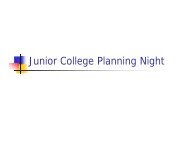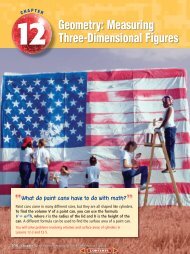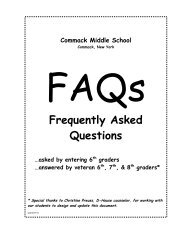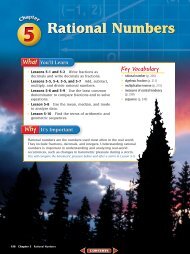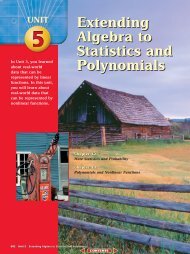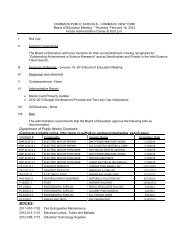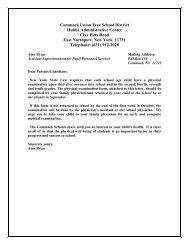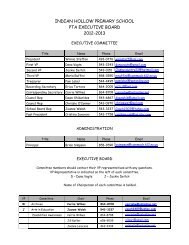Preparing for the Regents Examination Geometry, AK
Preparing for the Regents Examination Geometry, AK
Preparing for the Regents Examination Geometry, AK
You also want an ePaper? Increase the reach of your titles
YUMPU automatically turns print PDFs into web optimized ePapers that Google loves.
3 4x 2 3x 3<br />
x 5<br />
RS 18<br />
4 Perimeter of MABC 8<br />
5 mADC 110<br />
6 2x 2 x 8<br />
x 10<br />
CD 18<br />
7 mADC 94<br />
8 a Midpoint of −−<br />
AC midpoint of −−<br />
BD (6, 5)<br />
b Slope of −−<br />
AC 1, slope of −−<br />
BD 1.<br />
Slopes are negative reciprocals, diagonals<br />
are perpendicular.<br />
9 a (9, 5)<br />
b PQ PS 5 √ 2<br />
c Slope of −−<br />
PR 1 _ , slope of<br />
3 −−<br />
QS 3.<br />
Slopes are negative reciprocals, diagonals<br />
are perpendicular.<br />
10 a Slope of −−−<br />
AD slope of −−<br />
BC k _<br />
x<br />
.<br />
AD BC √ x 2 k 2 . ABCD is a parallelogram.<br />
(One pair of opposite sides have<br />
<strong>the</strong> same length and are parallel.)<br />
b Slope of −−<br />
CA k _<br />
−−<br />
, slope of BD <br />
x k k _<br />
x k ,<br />
not negative reciprocals. The diagonals are<br />
not perpendicular.<br />
Note: Since <strong>the</strong>re are many variations of proofs,<br />
<strong>the</strong> following is simply one set of acceptable<br />
statements to complete each proof. Depending<br />
on <strong>the</strong> textbook used, <strong>the</strong> wording and <strong>for</strong>mat<br />
of reasons may differ, so <strong>the</strong>y have not been<br />
supplied <strong>for</strong> <strong>the</strong> method of congruence applied<br />
in each problem. (These solutions are intended<br />
to be used as a guide—o<strong>the</strong>r possible solutions<br />
may vary.)<br />
11 −−−<br />
QR −−<br />
AC , −−<br />
PS −−<br />
AC , −−−<br />
QR −−<br />
PS . Likewise,<br />
−−<br />
QP −−<br />
BD , −−<br />
RS −−<br />
BD , and −−<br />
QP −−<br />
RS . Thus, PQRS<br />
is a parallelogram. Since −−<br />
AC −−<br />
BD , −−−<br />
QR<br />
and −−<br />
PS are perpendicular to −−<br />
QP and −−<br />
RS .<br />
Thus, PQRS has at least one right angle, and<br />
PQRS is a rectangle.<br />
12 1. Rhombus ABCD<br />
2. −−<br />
ED<br />
3. −−<br />
BF −−<br />
AC<br />
4. −−<br />
EF −−<br />
AC<br />
5. F bisects −−<br />
AC .<br />
6. EA EC<br />
62 Chapter 10: Quadrilaterals<br />
7. −−<br />
EA −−<br />
EC<br />
8. ACE is isosceles. (Definition of an<br />
isosceles triangle)<br />
13 Prove that −−<br />
DF −−<br />
AB and −−<br />
DE −−<br />
BF by using<br />
<strong>the</strong> midpoints and alternate interior angles.<br />
Thus, EBFD is a parallelogram. By <strong>the</strong> division<br />
postulate, −−<br />
EB −−<br />
FB . EBFD is a rhombus<br />
because a rhombus is a parallelogram with<br />
two congruent consecutive sides.<br />
14 1. Parallelogram ABCD<br />
2. −−<br />
AB −−−<br />
CD<br />
3. BAD 2<br />
4. mBAD m2<br />
(Corresponding angles<br />
are congruent.)<br />
5. BAD 1 CAD<br />
6. mBAD m1 (Whole is greater<br />
than a part.)<br />
7. m2 m1 (Substitution<br />
postulate)<br />
15 1. Rhombus PQRS<br />
2. −−<br />
QS −−<br />
PR<br />
3. −−−<br />
QC −−<br />
CS<br />
4. B is <strong>the</strong> midpoint of −−−<br />
QC .<br />
5. D is <strong>the</strong> midpoint of −−<br />
CS .<br />
6. −−<br />
BC −−−<br />
CD<br />
7. ___<br />
AC ___<br />
AC<br />
8. ABC ADC<br />
9.<br />
(SAS SAS)<br />
−−<br />
AB −−−<br />
AD<br />
(CPCTC)<br />
10. BAD is isosceles. (Definition of an<br />
isosceles triangle)<br />
16 If a quadrilateral is equilateral, it is a parallelogram<br />
with a pair of consecutive congruent<br />
sides.<br />
17 The diagonal creates two congruent triangles<br />
(ASA ASA) and corresponding congruent<br />
sides are consecutive.<br />
18 1. −−−<br />
CD BE <br />
2. −−−<br />
CD −−<br />
BA<br />
3. −−−<br />
AD BF <br />
4. −−−<br />
AD −−<br />
BC<br />
5. ABCD is a ( Definition of a<br />
parallelogram. parallelogram)<br />
6. BAD BCD (Opposite angles<br />
7. BG bisects FBE.<br />
are congruent.)<br />
8. CBD ABD<br />
9. ABCD is a rhombus. (Diagonal −−<br />
BD<br />
bisects opposite<br />
angles.)




